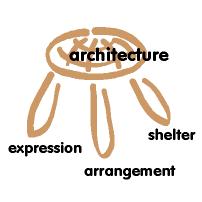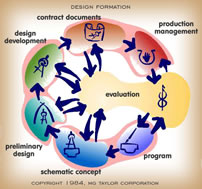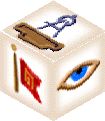• link:
Matt Taylor Studio Project •
• link:Pattern Language •
• link: Xanadu
Project •
• link: My Palo Alto Workspace •
• link: Work Index *
|
| A
true work of architecture [link] - as any art -
expresses a a singular theme that integrates all
the aspects
of the piece into one coherent whole. Everything
emanates from this focus and expresses it. Without
this thematic integrity, a work is merely a conglomeration
of parts which lack power. |
 |
| Architecture
has three attributes - take one away and you
do not have it. These, shelter, arrangement
and expression have to be in balance. They
are integrated and made harmonious by the THEME of a work. |
|
| Architecture
must integrate the attributes of shelter, arrangement
and expression in such a way that both augments and
expresses a way of life - and working. Great architecture
does this in a way that leads
those who use it [link] to
a fuller understanding of life’s potential and
provides means to
achieve that potential. Architecture is not a visual
art. It is fact-based. Architecture is the ART of
experience. It is a major tool for the art
of living [link]. |
| Deriving
a work’s THEME [link] is
a major step in the process of making architecture.
It is like creating the mission statement for an
organization. It is the goal statement - the standard
- that makes feedback [link] possible.
Without this, everything is arbitrary. One way of
solving any problem is as good as any other as long
as the problem is worked out. With theme,
however, each problem can be solved on it’s
own level (of recursion)‚ and in reference
to the overall purpose/function of the work. Theme
makes integration, and layers of meaning, possible. |
 |
| THEME has
to be recreated [link] at
each step of the Design Formation Model. It
is first discovered and developed in the Program
and Schematic Design stages. To proceed too
far in the design process without understanding
the theme of the work is a grave mistake. |
|
| The
theme of a work evolves out of it’s program.
It is expressed, first, in the schematic phase
of development. It is developed throughout each
subsequent work phase and is only fully realized
with USE. How the building is employed is
equally as important as the effort that goes into
it’s design. The entire Design,
Build, Use [link] cycle
makes the art of architecture. THEME cannot
be imposed. It emerges in the early design
process as a result of thought and contemplation
about the true meaning of the work. What is this
space about? what values does it represent, express,
promote? What happens here? What happens here that
cannot happen anywhere else in exactly the same
way? What point of view, what capacity is unique
to this place? What human experience
will be created here? Theme can never be forced.
It cannot be totally understood or controlled either.
It can be brought forth by a systematic
process. |
| Theme
speaks in the language of denotation and connotation.
Colors, textures, forms, masses, and the order of
their assembly, have direct tactile presence and
social meaning. It is through the composition of
these elements that idea is expressed by and fused into
physical form. The physically of a built environment
changes over time. A new work can never match the
quality of a well designed and built place that has
been lived in and evolved with care and craft. The
energy of use becomes the memory of thing [link]. Thing
expresses spirit; spirit becomes thing. The
built work [link] is the
direct expression of the builders and their society. |
| Theme,
therefore, is not just an idea to employ while making
a design - it is that. Theme becomes the thing.
Beyond being a tool of the design process, it is the
soul of the work. This is not an a device - a mere
intellectual conceit. It cannot be faked. This is
why the way a building is built is so important.
People energy, for good or bad, is bonded in the
result. This is a secrete that every craftsman knows.
The attention given to one’s own mental state and the
detail of the work is what makes craft. It
is, of course, a view and a practice that emanates
from a completely different set of assumptions than
the common build-it-for-money (only), mechanistic
paradigm. Architecture cannot be had that way. It
takes cathedral
builders [link] to
do a great work. |
| Theme
demands. It challenges the design, build, use team.
It sets the standard of performance. It also teaches
and guides. To create a theme for a work is to accept
a strict master who will require your best attention
and effort. If the theme does not place you on the
performance edge the resulting work is perfunctory
and normal. It will lack life. It will be stale. |
| A
building’s theme starts the process of finding
the vocabulary of a work. It acts as a mental armature
that allows design team members to bring a great
range of their individual perspective to the process
while achieving an integrated result. Harmony and diversity
- both necessary values. A building’s vocabulary
is expressed, in a material way, by the grammar employed
in it’s execution. This grammar is expressed,
primarily, by the palette [link] employed
and the module [link] used.
The module schema provides the scaffolding from which FORM emerges
and structure is determined. |
| Of
course, this is not arrived at in a linear and mechanical
way. THEME is discovered. It emerges from
thought and dialog with a broad community engaged
in the work. It is an act of philosophy and design.
It is not entirely the result of conscious, rational
thought. It is aided by meditation, imagination,
serendipity and inspiration. |
| A
theme is usually captured in the Program Statement
of a work and expressed in the schematic sketches.
This is, perhaps, the major role of SCHEMATICS -
to render the essence of a work in a way that
provokes a creative response from the community who
will build and employ it. The schematic design creates
a formal problem [link: creating the problem] that
the community of designer-builders are challenged
to solve. |
rands_architectural_themes |
| A
brilliant example of theme is provided by Ayn Rand
in the Fountainhead. It is the scene where
a boy on a bicycle comes across one of Roark’s projects
[link: rand, young man].
The theme of the book and the project, within the story, are
both explicated in a short, powerful
description. Not only is this an excellent piece
of writing, it is provocative thematic description
of an architectural idea [link: rand’s architectural themes]. Roark’s explanation of
the project to the clients, elsewhere
in the book, is an excellent example
of an outline program statement. Rand’s descriptions in The Fountainhead are serious examples of the philosophical and thematic aspects of a Program Statement [link: modeling language]. |
| It
is the idea embedded in a work that provides
it meaning and life. This idea is capitalized in
the theme of the work. The theme is made
real by the use of denotation and connotation in
the selection of materials, colors, shapes, forms
and masses. It is embedded and, thus, pervasive in
a work when it drives every esthetic decision made
in the process of creating the work. This is a major
factor, like is Pattern Language, in the making of
architecture. It is not the only factor. However,
take it out and you have a building, not art. |
| Bernard Maybeck’s Masterpiece, the Christen Science Church in Berkeley [link: first church of christ scientist], is an excellent example of unity of theme. This work was designed a 100 years ago yet today inspires as strongly as ever. It has become one of a few creations which epitomizes the “Bay Area Style,” in effect, becoming a regional brand. Maybeck was a modest man and gentle architect. He did not force a design onto an architectural problem. Always eclectic and sensitive to place, his works emerged in a graceful way and became icons of an unique sensibility based on a philosophy of life. Even in our over-hyped and frenetic times, he reminds us of a time and place when another approach to living briefly flowered and still remains deeply embedded in the consciousness of Northern California. Maybeck practiced without hyperbole, controversy or competitiveness. His buildings, most of them simple and inexpensive, never failed to enhance the landscape of which they blended into and became a part. Maybeck’s works [link: maybeck and his work] are always present and strong yet never overwhelming and this is something that modern architects should take a good look at. |
|
The Making of tsmARCHITECTURE... |
| My goal for tsmARCHITECTURE is not the creation of a personal architectural practice to only express my way of designing and building individual works of art. My own individual practice still remains a facet of my “retirement” plan. The purpose of tsmARCHITECTURE is to create a modern version of the Cathedral Builders. It is to create a diverse ValueWeb of artists, engineers, architects, craftsmen, and users who create and live-work in a body of works created by the application of the Taylor System and Method. |
| This Method is a way of working. It is based on a way of seeing the world and the potential in it. it is based on a sense of life and a vision of what life can be. It seeks to fuse the ideal and the practical healing the soul-body, mind-matter dichotomy which has so long ruled Western thought and is running ramped now. |
| The practice scope of tsmARCHITECTURE is to be from furniture, interiors and individual buildings, to infrastructure and developments, so as to provide a means by which Planetary Architecture can be carried out with respect to Gaia and regional-local cultures making an architecture which supports all life on Planet earth and in near space. The Taylor Method is a process Armature by which this scope can be carried out by a diverse, creative group capable of GroupGenius and individual brilliance. A work of several generations to repair past damage and to recreate Earth as a Garden and living work of Art. |
| This cannot be achieved as a static, designed-top-down, dogmatic expression of a single mentality and style. A viable Planetary Architecture is by definition emergent. All life has to be involved in the making of it. Unity and Diversity have to co-operate. While true that even a single building should reflect this approach, the criticalness of doing so scales with complexity. One can, with great thought and care, pull off a single building but not a city or a planet. |
| It is not expected that all members of the tsmARCHITECTURE ValueWeb only practice as a member of this group. This actually would defeat the purpose of the enterprise. Most will have their individual practices. Teams will form around specific projects. The glue which binds the practice will be a set of principles and methods not one or a few dominate personalities. Nor is the goal to scale tsmARCHITECTURE to become a huge enterprise. It has to be big enough to do the work for which was conceived and no bigger. The mission is not only to do; it is also to make ubiquitous the way. tsmARCHITECTURE can dissolve when global standards of architecture reflect this approach. |
|
Theme, Brand & Architecture... |
There is a close relationship between theme and how it can be used in architecture and brand as described in Do You Matter? by Robert Brunner and Stewart Emery. The subtitle of this book is How great design will make people love your company. The authors stress the importance of making the customer experience your focus and to integrate every thing and process to express the central idea of the value you bring to each customer’s experience. This is what authentic architecture does. This is why I stress it is not a visual art - although it employs strong visual means - it is an experiential art. The MG Taylor DesignShop® experience carries this philosophy into the realm of collaborative design. |
 |
Brunner and Emery talk about the FLAVOR of a brand:
Focus
Long-Term Authentic Vigilant Original Repeatable
All elements of true theme. All aspects of good design. All necessary to architecture. |
|
| Brand experienced this way and understood in the way of Do You Matter? is a completely different way of branding then the common commercial approach. It is an embedded idea just as I talk about embedding idea in the making of architecture. Brand, as the authors point out, is not a logo and slogan any more than “style” superficially “attached” to a building is true design. The brand, and the promise it represents, pervades all aspects of the enterprise. In do so it defines the customer experience. In do so it becomes a contract. |
|
|
|
|
| GoTo:
Criteria For Making Architecture |
|
|
|
|
| GoTo:
Gail’s Nest Program |
|
|
|
|
| GoTo:
SETI Visitor Center |
|
|
|
|
| GoTo:
Taylor Environments - A Tour |
|
|
|
|
| GoTo:
THESIS: Making Authentic Architecture |
|
|
Matt
Taylor
Cambridge
August 12, 2001

SolutionBox
voice of this document:
VISION • STRATEGY • SCHEMATIC
|
|
click on graphic for explanation of SolutionBox |
posted:August
12, 2001
revised:
December 31, 2009
•20010812.376666.mt • 20011022.124643.mt •
• 20011223.276109.mt • 20030518.222200.mt •
• 20050709.123487.mt • 20091231.201099.mt •
Copyright© Matt
Taylor 2001, 2003, 2005, 2009
|
|
|